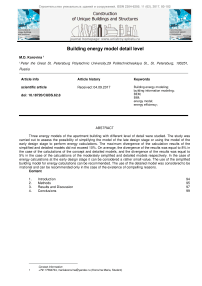Building energy model detail level
Автор: Korovina Maria
Журнал: Строительство уникальных зданий и сооружений @unistroy
Статья в выпуске: 11 (62), 2017 года.
Бесплатный доступ
Three energy models of the apartment building with different level of detail were studied. The study was carried out to assess the possibility of simplifying the model of the late design stage or using the model of the early design stage to perform energy calculations. The maximum divergence of the calculation results of the simplified and detailed models did not exceed 10%. On average, the divergence of the results was equal to 8% in the case of the calculations of the concept and detailed models, and the divergence of the results was equal to 5% in the case of the calculations of the moderately simplified and detailed models respectively. In the case of energy calculations at the early design stage it can be considered a rather small value. The use of the simplified building model for energy calculations can be recommended. The use of the detailed model was considered to be irrational and can be recommended only in the case of the existence of compelling reasons.
Building energy modeling, building information modeling, bem, bim, energy model, energy efficiency
Короткий адрес: https://sciup.org/143163571
IDR: 143163571 | DOI: 10.18720/CUBS.62.8
Список литературы Building energy model detail level
- Yalcinkaya M., Singh V. Patterns and trends in Building Information Modeling (BIM) research: A Latent Semantic Analysis. Automation in Construction. 2015. No. 59. Pp. 68-80.
- Kontes G., Valmaseda C., Giannakis G.I., Katsigarakis K.I., Rovas D. Intelligent BEMS design using detailed thermal simulation models and surrogate-based stochastic optimization. Journal of Process Control. 2014. No. 24(6). Pp. 846-855.
- Tabunshchikov Y.A., Brodach M.M. Matematicheskoe modelirovanie i optimizaciya teplovoj ehffektivnosti zdanij . Moscow: ABOK, 2012. 204 p. (rus)
- Tabunshchikov Y.A., Shilkin N.V., Miller N.V. Ekspress-ocenka effektivnosti energosberegayushchego oborudovaniya, tekhnologij i meropriyatij . Izvestiya vysshih uchebnyh zavedenij. Stroitel'stvo. 2013. No. 6(654). Pp. 57-63. (rus)
- Schwartz Y., Raslan R. Variations in results of building energy simulation tools, and their impact on BREEAM and LEED ratings: A case study. Energy and Buildings. 2013. Vol. 62. Pp. 350-359.
- Rehab I., Andre P., Aparecidia Silva C., Massy G., Hannay J., Lebrun J. Verification of the energy balance of a passive house by combining measurements and dynamic simulation. Energy Procedia. 2015. No. 78. Pp. 2310-2315.
- Royapoor M., Roskilly T. Building model calibration using energy and environmental data. Energy and Buildings. 2015. No. 95. Pp. 109-120.
- Pang X., Bhattacharya P., O’Neill Z., Haves P., Wetter M., Bailey T. Real-time building energy simulation using EnergyPlus and the building controls virtual test bed. Proceedings of Building Simulation 2011: 12th Conference of International Building Performance Simulation Association. Sydney, 2011.
- Gorshkov A.S., Sokolov N.A. Nesootvetstvie rossijskih i mezhdunarodnyh standartov pri opredelenii raschetnyh znachenij teploprovodnosti stroitel'nyh materialov i izdelij . Magazine of Civil Engineering. 2013. No. 7(42). Pp. 7-14. (rus)
- Vatin N.I., Nemova D.V., Rymkevich P.P., Gorshkov A.S. Vliyanie urovnya teplovoj zashchity ograzhdayushchih konstrukcij na velichinu poter' teplovoj ehnergii v zdanii . Magazine of Civil Engineering. 2012. No. 8(34). Pp. 4-14. (rus)
- Bubnov Y., Denisikhina D. Energomodelirovanie zdanij -investicii v proshloe i budushchee . Zdaniya vysokih tekhnologij. 2016. Vol. 1 No. 1. Pp. 20-25. (rus)
- Tabunshchikov Y.A., Brodach M.M. Nauchnye osnovy proektirovaniya ehnergoehffektivnyh zdanij . АВОК. 1998. No. 1. Pp. 5. (rus)
- Sovetnikov D.O., Semashkina D.O. Proektirovanie i analiz ehnergoehffektivnosti doma, udovletvoryayushchego principam standarta «Passivhaus» . Construction of Unique Buildings and Structures. 2016. No. 6 (45). Pp. 68-88. (rus)
- Burtseva V.S., Denisikhina D.M., Teslya E.S. Energeticheskaya model' zdaniya -shag vpered v proektnom processe . Stroitel'nye materialy, oborudovanie, tekhnologii XXI veka. 2013. No. 12 (179). Pp. 35-37. (rus)
- Gerrish T., Ruikar K., Cook M., Johnson M., Phillip M., Lowry C. BIM application to building energy performance visualisation and management: Challenges and potential. Energy and Buildings. 2017. Vol. 144. Pp. 218-228.
- Granadeiro V., Duarte J.P., Correira J.R., Leal V.M.S. Building envelope shape design in early stages of the design process: Integrating architectural design systems and energy simulation. Automation in Construction. 2013. No. 32. Pp. 196-209.
- Bolotin S.A., Gurinov A.I., Dadar A.H., Oolakay Z.H.-O. Ocenka ehnergoehffektivnosti arhitekturno-stroitel'nyh reshenij nachal'nogo ehtapa proektirovaniya v programme Revit Architecture . Magazine of Civil Engineering. 2013. No. 8. Pp. 64-91. (rus)
- Korovina M. The applicability of the BIM technology in Russia. . System requirements: AdobeAcrobatReader. URL: http://urn.fi/URN:NBN:fi:amk-2016120619217 (date of application: 28.04.2017)
- Holzer D. BIM's seven deadly sins. International Journal of Architectural Computing. 2011. Vol. 9(4). Pp. 463-480.
- Bashmakov I.A. Ehnergoehffektivnost' zdanij v rossii i v zarubezhnyh stranah . Ehnergosberezhenie. 2015. No. 3. Pp. 24-29. (rus)
- Gorshkov A.S., Rakova K.M., Musorina T.A., Tseytin D.N., Agishev K.N. Proyekt zdaniya s nizkim potrebleniyem teplovoy energii na otopleniye//Stroitelstvo unikalnykh zdaniy i sooruzheniy. 2015. № 4 (31). S. 232-247.
- Gagarin V.G. Metody ehkonomicheskogo analiza povysheniya urovnya teplozashchity ograzhdayushchih konstrukcij zdanij . ABOK. 2009. No. 1. Pp. 10-16. (rus)
- Mitterer C., Kunzel H.M., Herkel S., Holm A. Optimizing energy efficiency and occupant comfort with climate specific design of the building. Frontiers of Architectural Research. 2012. No. 1. Pp. 229-235.


